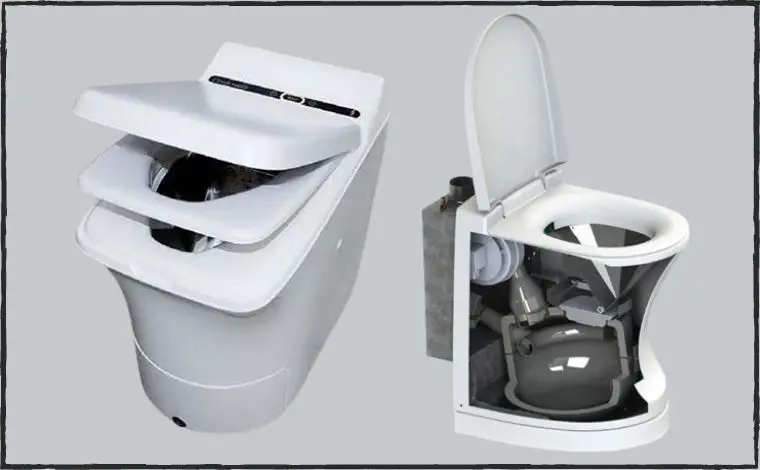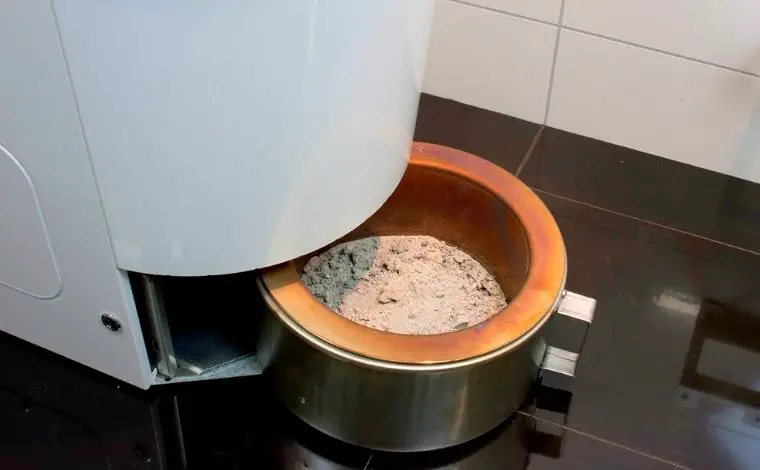Have you ever imagined that your toilet waste is burned into ashes? Even the toilet does not use a single drop of water to sweep away the waste. Are you shocked to hear that? Do not be surprised because modern technology has turned this into reality. This type of toilet is called the incinerator toilet, and they do not need water or a septic tank to dump the waste; they simply burn the waste into ashes in the burning chamber. But why should you install this in your home, and what are the facilities of this toilet? In this article, I will describe all these issues and also discuss how to install this toilet in your bathroom. Okay, let things get started.
How does an incinerator toilet work?
An incinerator toilet is not a common type of toilet. It’s far away, different from the normal toilets. Now the question arises what an incinerator toilet is? An incinerator toilet is a kind of toilet that uses a unique electrical system to burn away the waste without the help of water. You don’t need a toilet flush or any kind of septic tank to support this toilet system. A special type of burning chamber reaches 900 to 1400 degrees Fahrenheit while operating. An electrical system turns electric power into extreme heat that completely burns down the waste.
It is a matter of pleasure that these waste ashes can be used as compost and can be applied in gardening and planting. The ashes are virtually free from any kind of severe odor or nuisance. This organic compost has proved to be a great fertile element for plants. This can be the best kind of eco-friendly toilet as it is tremendously water saving, and also, the organic compost is a nature-friendly product. For these reasons, the incinerator toilet is gaining much popularity in the USA.
Advantages of using the incinerator toilet
There are lots of unique advantages of the incinerator toilet, and these advantages are the main cause that the users are getting too much attracted to this toilet system. Let us explore those unique advantages in a detailed manner,
- The main advantage is that it doesn’t use a single drop of water to dump the waste. Instead, it uses a burning chamber to maintain the waste.
- This type of toilet is suitable for remote areas kike the icy areas or the dry deserts where water is so much rare.
- It incorporates an odorless system that creates not that much nuisance, and at the same time, the sterile ashes are used in farming vegetables and flowers. This also saves the extra cost of composting and pesticides.
- Incinerator toilets are portable, which means you can convey this toilet anywhere; that’s why it is widely used in the caravan and portable washrooms. The final product of this toilet is the burning ashes, and nearly one tablespoon of ashes is generated peruse.
- The maintenance of incinerator toilets is super easy and does not even need a strong cleaning agent to maintain the toilet bowl.
- There is no hassle of installing the toilet tank and septic tank or the entire sewage system as it does not need any of these. So it is fantastically simple to install as there are no additional parts to be installed.

What are the negative sides?
Nothing in this world comes with complete merits. There must be some sorts of disadvantages. Apart from the advantages now we will check some of the demerits of the incinerator toilets. Some of the biggest disadvantages are,
- The most annoying demerit of the incinerator toilets is that they are extremely expensive. One incinerator toilet can cost you more than 2500$, which is just too much for a toilet.
- Another major demerit is that incinerator toilets are highly energy-consuming. Though they do not use water, it uses excess electricity for the burning process. Can you imagine how much electricity is required to burn a huge amount of solid waste? Really it skyrockets your electricity bill.
- Though we consider it a nature-friendly composition, it is not always true. The waste that is converted into ashes may not possibly contain all the minerals needed to produce plants. Antifoam agents, catalysts, or other additives are typically required to use.
- The incinerator toilets may produce extreme temperatures, so you can not use this toilet when the burning operation is on.
How expensive is this toilet?
The biggest uncomfortable issue about the incinerator toilets is that they are massively costly. The cost varies depending on the toilet’s mechanism. The propane-burning Storburn costs nearly 2600$, and the natural gas-burning unit costs between 2400$ to 2600$. This is the biggest obstruction from being a massively popular toilet; the manufacturers need to find some way to reduce the purchasing cost. Otherwise, it won’t be a signature commodity in the domestic washrooms.
The complete installation process of the incinerator toilet:
The most convenient fact about the incinerator toilet is that the installation process is super simple compared to the traditional toilets. You do not need to install the tanks, bowls, septic combination, or water supply hose. Just install the electrical line and the venting line; that’s it, you are ready to go with the incinerator toilet.
Step-1: Primary preparation
Unbox the whole packaging and check the manual if all the parts are carried away in the box. Visually inspect the toilet itself, and check the knobs and the exterior. Then calculate the rough-in measurement. Keep much space behind the toilet for installing the electrical wires and vent line. Also, keep some space on the left and right sides of the toilet for additional safety. The next step is to install the wirings and the vent line.
Step-2: Electrical wirings installation
The electrical connection is very much simple in this type of toilet. It has a 20-amp plug, so it also needs a 20-amp socket or receptacle to fit into. It has a 4 feet long power cord, which means it can cover a decent distance between the toilet and the socket. The toilet has a push button, and after pressing the button, the toilet operations start.
Step-3: Install the vent line
Finally, install the vent line perfectly. The main intention of using this is to evacuate the foul odor from the washroom and make the toilet cool after the burning operation. The vent line can be installed both horizontally or vertically. Just make sure that the diameter of the pipe is large enough to get rid of bad odor. After the incinerator toilet is connected to the vent line and plugged into a 20 amp socket on a 20 amp circuit of the appropriate voltage, test the toilet by pouring a bucket of water. That’s it. You are done with installing the incinerator toilet.
How to properly utilize the incinerator toilet?
As it is a new type of product, the using process might not be known to some users; for the convenience of the users, let us elaborate on the detailed process of using this toilet.
- Place the particular liner in a bowl. After use, face the toilet, step on the foot pedal to open the bowl, and allow waste to drop into the incineration chamber. Make certain that the top edges of the liner are below the lid when the lid closes. If you do not use the bowl liner, then all the liquid substances may spill out of the toilet and create a bad nuisance in the washroom.
- You need to press the start button after each use, and immediately the burning process may start. You can still use the toilet when the incineration process is ongoing.
- Keep a close eye on the ashpan. If the ashpan is overloaded, it can cause harm to the burning unit and cause early heater failure, odor, and overflow of waste inside the toilet and onto the floor. So to avoid the possible nuisance from the waste ashes, routinely clean the ashpan.
How to maintain the incinerator toilet?
The maintenance of the incinerator toilet is very much simple. You just need to clean the ash pan and the toilet bowl. You can use compatible detergent or a spray cleaner to clean the toilet bowl, toilet seat, and the exterior of the toilet. There is an ash pan at the bottom of the toilet. The ash pan is attached with a special kind of element that is called the cam lock handle. Safely remove the ash pan and empty the ashes into a dustbin. Clean the bowl liners with compatible detergent. Sweep the outer portion with a soft wiper and remove dust carefully. That’s it for the cleaning process.
Final words
You must have gone through the whole working mechanism of the incinerator toilet. It is a special kind of toilet indeed. Traditionally, we see the normal toilets that use water pressure to sweep away the sludges and wastes. But in this case, the fact is totally opposite. That’s why this type of toilet is getting more famous in the world, including in the USA. So Incinerating toilets are mostly ideal for the application at sites where water is insufficient, like the icy cold areas and the deserts or the servicing sites which receive minimal use of water. In the case of gas-fired incinerator toilets, sometimes electrical service is not required. This type of toilet is best used for public gatherings where water is limited. Just clean the ashes, and you are again ready to go with the incinerating toilets.
FAQs
How often do you have to empty the ashes from the incinerating toilets?
It is an astonishing fact that ashes from this toilet are designed to be at a minimum rate. It is compatible with a family consisting of 3 to 4 members. You do not need to clean the ashes after use frequently; it only produces a tablespoon of ashes. You can clean the ash pan every 3 to 4 weeks.
Can you urinate in the incinerating toilets?
The toilet is mainly designed to burn and evacuate solid feces, urine, sanitary napkins, and many other disposable toilet accessories. But keep in mind that do not throw anything that can not be burned out.
Where to find incinerating toilets?
Incinerating toilets are not that common in the market. So you can go for the online platforms to have one of these. You can order the incinerating toilets from the biggest online sites like Amazon, Walmart, Alibaba, and so on.
We are really lucky to have a hard-working, multi-skilled plumber on our team. Collin D. Gallegos, a professional plumber who has worked with us since 2012, is an expert in vent, septic, and drainage systems. He is a Certified Master Plumber and has worked on various commercial plumbing projects. He usually helps our readers resolve plumbing and pipe-related issues with a proper DIY troubleshooting and repair guide.